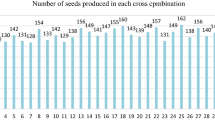Abstract
Three populations of an intervarietal durum wheat cross IWP5308/PDW208, F5, F5BIP1 (population derived after intermating in F2) and F5BIP2 (population derived after intermating in BIPF1), were evaluated under three different agronomic environments for mean performance and stability of genotypes for grain yield, yield components and protein content. Though the biparental progenies indicated a higher mean performance, they did not differ significantly from progenies of the pedigree method for almost all characters. The biparental progenies, however, produced a higher number of stable genotypes for grain yield per plant, grains per ear and protein content. The F5 population had a higher number of stable genotypes for 1000 grain weight and number of tillers per plant. The BIP progenies also had a higher number of genotypes with above average mean performance, and many were significantly higher than the checks WH896 and WH542, compared with F5 progenies. Hence, in spite of high G x E interactions, the use of cycles of biparental mating and selection of top yielding lines on the basis of yield components can enable selection of stable genotypes with high protein content. Number of tillers per plant and 1000 grain weight were the yield component characters which made maximum contribution to phenotypic stability of the genotypes.
Similar content being viewed by others
References
Chander, S., R.B. Srivastava & M. Yunus, 1993. Impact of intermating on population mean and genetic advance in wheat (Triticum aestivum L. em. Thell). Cereal Res Comm 21: 201–205
Joshi, A.B., 1979. Breeding methodology for autogamous crops. Indian J Genet 39: 567–578.
Kanbertay, M.& I. Demir, 1985. Studies on the inheritance of mealy endosperm and selected agronomic traits in four crosses of durum wheat. Ege Universiteti Ziraat Fakultesi Dergisi 21(2): 9–11.
Pecetti, L.; G. Boggini & J. Gorham, 1994. Performance of durum wheat landraces in a Mediterranean environment (eastern Sicily). Euphytica 80: 191–195.
Perkins, J.M. & J.L. Jinks, 1968. Environmental components of variability. VI. Diallel sets of crosses. Heredity 23: 339–356.
Saini, D.P. & P.L. Gautam, 1990. Notes on G x E analysis in segregating populations of durum wheat. Indian J Genet 50: 199–201.
Sethi, S.K., 1995. Component selection in selfed and intermated populations for the improvement of durum wheat (Triticum durum Desf.). Ph.D. thesis, CCS Haryana Agricultural University, Hisar, India.
Simane, B., P.C. Struik, M.M. Nachit & J.M. Peacock, 1993. Ontogenetic analysis of yield components and yield stability of durum wheat in water limited environments. Euphytica 71: 211–219.
Srivastava, R.B., R.S. Paroda & S.K. Sethi, 1993. Effectiveness of commonly used mating systems and methods of generation advance in wheat - A retrospect. Pl Breed Abst 63(12): 1613–1619.
Author information
Authors and Affiliations
Rights and permissions
About this article
Cite this article
Verma, S., Yunus, M. & Sethi, S. Breeding for yield and quality in durum wheat. Euphytica 100, 15–18 (1998). https://doi.org/10.1023/A:1018335402010
Issue Date:
DOI: https://doi.org/10.1023/A:1018335402010




